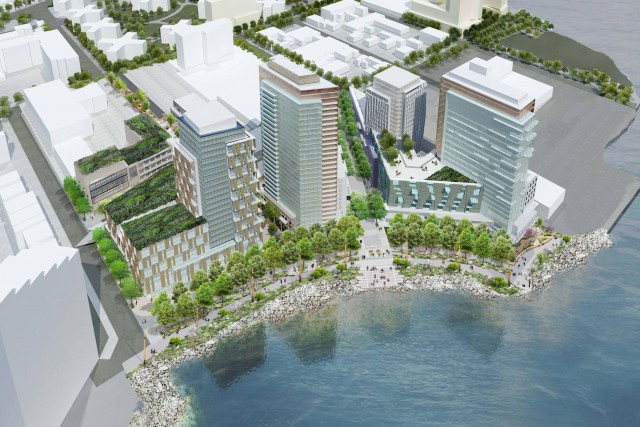Yesterday, the City Council’s Land Use Committee approved the Astoria Cove high-rise mega-development on the Queens waterfront. The general sketch of the deal is that in exchange for tax breaks and building on land that was previously zoned only for industrial and priced accordingly, the developer rents 27 percent of the 1,700 apartments at rates far below their market value.
Politicians crowed on Twitter about a New York Times article hailing the deal, calling it “a crucial test of Mayor Bill de Blasio’s ability to meet his soaring promises on affordable housing.” Costa Constantinides, Astoria’s council representative, invoked de Blasio’s favorite word, “historic,” to describe it. As usual, the de Blasio administration took a swipe at Bloomberg in their statements:
His aides say this an improvement over earlier administrations’ efforts at cajoling developers to build affordable units voluntarily through tax breaks. Where New York real estate is concerned, mandatory zoning [sic] — with permanent affordability — looks like the more effective tactic. Mr. de Blasio is a long way from 200,000 units, but Astoria Cove is an encouraging step in that direction.
But how “soaring” and “historic,” how much of “an improvement” was the deal over the Bloomberg formula? In fact, it really seems to be a fairly minor tweak on the previous administration’s policy – bumping the below-market share of the standard 80/20 deal to 27 percent, and then offsetting it a bit with some subsidies. The affordable housing and incentives are mandatory, but this is a continuation of the late Bloomberg era rezonings, where affordable housing set-asides were effectively, if not technically, required.
And contrary to the New York Times’s claim that de Blasio’s style of inclusionary zoning “requires a builder, without benefit of subsidies and incentives, to set aside a portion of a project as permanently affordable,” the administration still had to dole out plenty of the same subsidies and incentives as the Bloomberg administration.
The biggest is the 421-a tax abatement, whereby new buildings with affordable housing in the outer boroughs pay nothing in property taxes to the city for nearly 25 years.
But the de Blasio administration has also offered the developer extra subsidies to cover 2 percent of the units, meaning that the developer is really only throwing in for 5 percentage points more of the units than they would have under an 80/20 deal – in exchange for a rezoning on a scale much grander than many.
Finally, the city is also building a ferry landing to appease Councilman Costa Constantinides, and will presumably fund service for it later as well. While they’ll claim it’s about transit, the truth is that ferries along the East River are more of an amenity for rich people than a viable transit option for middle-class New Yorkers. The fares are far too high for anyone at, say, nearby Astoria Houses to consider using them – $4 during the week and $6 on the weekend for the East River Ferry service, with no free transfer to the subway. If the city and Constantinides want to effectively serve residents of the area, they would improve bus service in the area, bettering a mode which, unlike ferries, many New Yorkers actually use.
While some have already accused the de Blasio administration of not driving a hard enough bargain, the truth is that there simply isn’t as much room to squeeze developers beyond the typical 80/20 split, contrary to the thinking of many affordable housing advocates. This is especially true as land values rise in anticipation of more of these sorts of rezonings. Developer profits and land values are not infinite, no matter how much some might think it so.
And for better or worse, at least so far, the current mayor hasn’t shown that it’s possible to appreciably change tack from the Bloomberg years.
Talk about this topic on the YIMBY Forums
For any questions, comments, or feedback, email [email protected]
Subscribe to YIMBY’s daily e-mail
Follow YIMBYgram for real-time photo updates
Like YIMBY on Facebook
Follow YIMBY’s Twitter for the latest in YIMBYnews





